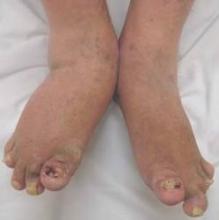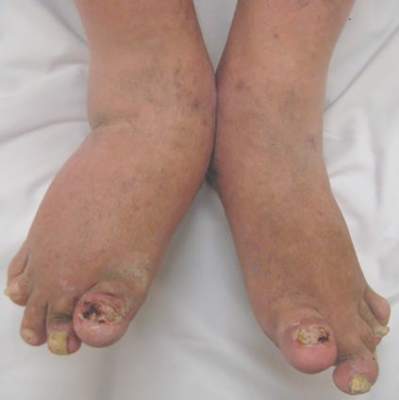User login
Baseline radiographic damage and the presence of dactylitis at 5 years are independent predictors of further joint destruction in people with psoriatic arthritis, according to follow-up data from a psoriatic arthritis registry.
The analysis of hand and foot radiographic findings from 72 patients (29 men, 43 women) participating in the Swedish Early Psoriatic Arthritis Registry (SwePsA) registry found that radiographic progression in early PsA was generally slow but was substantial in men. At entry to the registry, the patients had a mean age of about 48 years and had symptoms for a median of 12 months. Most had polyarticular disease as a result of the registry’s protocol, and none had arthritis mutilans or axial disease only. Three men and none of the women had combined axial and peripheral disease, reported Dr. Mats Geijer of the Center for Medical Imaging and Physiology at Skåne University Hospital, Lund, Sweden, and his colleagues (J Rheumatol. 2015 Oct 15. doi: 10.3899/jrheum.150165).
Only 4 (14%) of the men did not have radiographic changes at 5 years, compared with 17 (40%) women, making male sex a risk factor for structural abnormality (odds ratio, 4.09; 95% confidence interval, 1.2-13.8; P = .024). Most of the radiographic changes in men occurred in the feet. Baseline radiographic changes also were a significant predictor of additional radiographic damage at 5 years (OR, 3.4; 95% CI, 2.2-5.2; P less than .001).
In a multivariate linear regression analysis, only baseline radiographic score and the presence of dactylitis at 5 years were independent predictors of a high radiographic score at 5-year follow-up.
The findings suggested that men improve clinically but develop radiographic changes, whereas women show less clinical improvement but do not develop joint damage to the same extent as men. This gender-divergent behavior could be taken into consideration when planning treatment and care for patients, the authors said.
For example, women may require more interventions against functional deterioration and help coping with pain and men may need follow-up radiography, especially in the presence of dactylitis, high disease activity, and a known propensity for radiographic destruction, they suggested.
“Radiography and scoring the hands and feet at baseline are important and cannot be substituted with clinical signs, especially in men,” they concluded.
The study was supported by independent grants from the Swedish Psoriasis Foundation, Skåne University Hospital (SUS Fonder) and Pfizer.
Baseline radiographic damage and the presence of dactylitis at 5 years are independent predictors of further joint destruction in people with psoriatic arthritis, according to follow-up data from a psoriatic arthritis registry.
The analysis of hand and foot radiographic findings from 72 patients (29 men, 43 women) participating in the Swedish Early Psoriatic Arthritis Registry (SwePsA) registry found that radiographic progression in early PsA was generally slow but was substantial in men. At entry to the registry, the patients had a mean age of about 48 years and had symptoms for a median of 12 months. Most had polyarticular disease as a result of the registry’s protocol, and none had arthritis mutilans or axial disease only. Three men and none of the women had combined axial and peripheral disease, reported Dr. Mats Geijer of the Center for Medical Imaging and Physiology at Skåne University Hospital, Lund, Sweden, and his colleagues (J Rheumatol. 2015 Oct 15. doi: 10.3899/jrheum.150165).
Only 4 (14%) of the men did not have radiographic changes at 5 years, compared with 17 (40%) women, making male sex a risk factor for structural abnormality (odds ratio, 4.09; 95% confidence interval, 1.2-13.8; P = .024). Most of the radiographic changes in men occurred in the feet. Baseline radiographic changes also were a significant predictor of additional radiographic damage at 5 years (OR, 3.4; 95% CI, 2.2-5.2; P less than .001).
In a multivariate linear regression analysis, only baseline radiographic score and the presence of dactylitis at 5 years were independent predictors of a high radiographic score at 5-year follow-up.
The findings suggested that men improve clinically but develop radiographic changes, whereas women show less clinical improvement but do not develop joint damage to the same extent as men. This gender-divergent behavior could be taken into consideration when planning treatment and care for patients, the authors said.
For example, women may require more interventions against functional deterioration and help coping with pain and men may need follow-up radiography, especially in the presence of dactylitis, high disease activity, and a known propensity for radiographic destruction, they suggested.
“Radiography and scoring the hands and feet at baseline are important and cannot be substituted with clinical signs, especially in men,” they concluded.
The study was supported by independent grants from the Swedish Psoriasis Foundation, Skåne University Hospital (SUS Fonder) and Pfizer.
Baseline radiographic damage and the presence of dactylitis at 5 years are independent predictors of further joint destruction in people with psoriatic arthritis, according to follow-up data from a psoriatic arthritis registry.
The analysis of hand and foot radiographic findings from 72 patients (29 men, 43 women) participating in the Swedish Early Psoriatic Arthritis Registry (SwePsA) registry found that radiographic progression in early PsA was generally slow but was substantial in men. At entry to the registry, the patients had a mean age of about 48 years and had symptoms for a median of 12 months. Most had polyarticular disease as a result of the registry’s protocol, and none had arthritis mutilans or axial disease only. Three men and none of the women had combined axial and peripheral disease, reported Dr. Mats Geijer of the Center for Medical Imaging and Physiology at Skåne University Hospital, Lund, Sweden, and his colleagues (J Rheumatol. 2015 Oct 15. doi: 10.3899/jrheum.150165).
Only 4 (14%) of the men did not have radiographic changes at 5 years, compared with 17 (40%) women, making male sex a risk factor for structural abnormality (odds ratio, 4.09; 95% confidence interval, 1.2-13.8; P = .024). Most of the radiographic changes in men occurred in the feet. Baseline radiographic changes also were a significant predictor of additional radiographic damage at 5 years (OR, 3.4; 95% CI, 2.2-5.2; P less than .001).
In a multivariate linear regression analysis, only baseline radiographic score and the presence of dactylitis at 5 years were independent predictors of a high radiographic score at 5-year follow-up.
The findings suggested that men improve clinically but develop radiographic changes, whereas women show less clinical improvement but do not develop joint damage to the same extent as men. This gender-divergent behavior could be taken into consideration when planning treatment and care for patients, the authors said.
For example, women may require more interventions against functional deterioration and help coping with pain and men may need follow-up radiography, especially in the presence of dactylitis, high disease activity, and a known propensity for radiographic destruction, they suggested.
“Radiography and scoring the hands and feet at baseline are important and cannot be substituted with clinical signs, especially in men,” they concluded.
The study was supported by independent grants from the Swedish Psoriasis Foundation, Skåne University Hospital (SUS Fonder) and Pfizer.
FROM JOURNAL OF RHEUMATOLOGY
Key clinical point: Men with early psoriatic arthritis tend to improve clinically but develop radiographic changes over a 5-year period, whereas women show less clinical improvement but do not develop joint damage to the same extent as men.
Major finding: Only 4 (14%) of the men did not have radiographic changes at 5 years, compared with 17 (40%) women, making male sex a risk factor for structural abnormality (OR, 4.09; 95% CI, 1.2-13.8; P = .024).
Data source: A longitudinal cohort study of 72 patients with psoriatic arthritis from the Swedish Early Psoriatic Arthritis Registry.
Disclosures: The study was supported by independent grants from the Swedish Psoriasis Foundation, Skåne University Hospital (SUS Fonder) and Pfizer.

